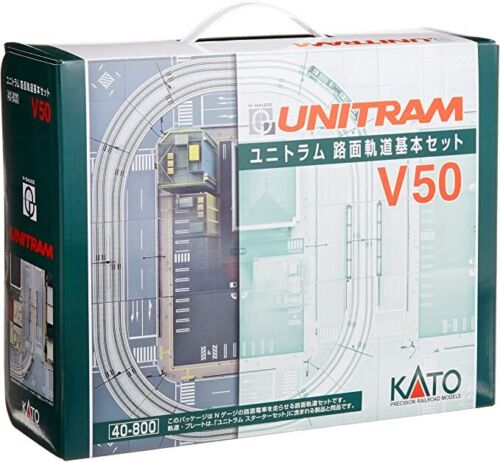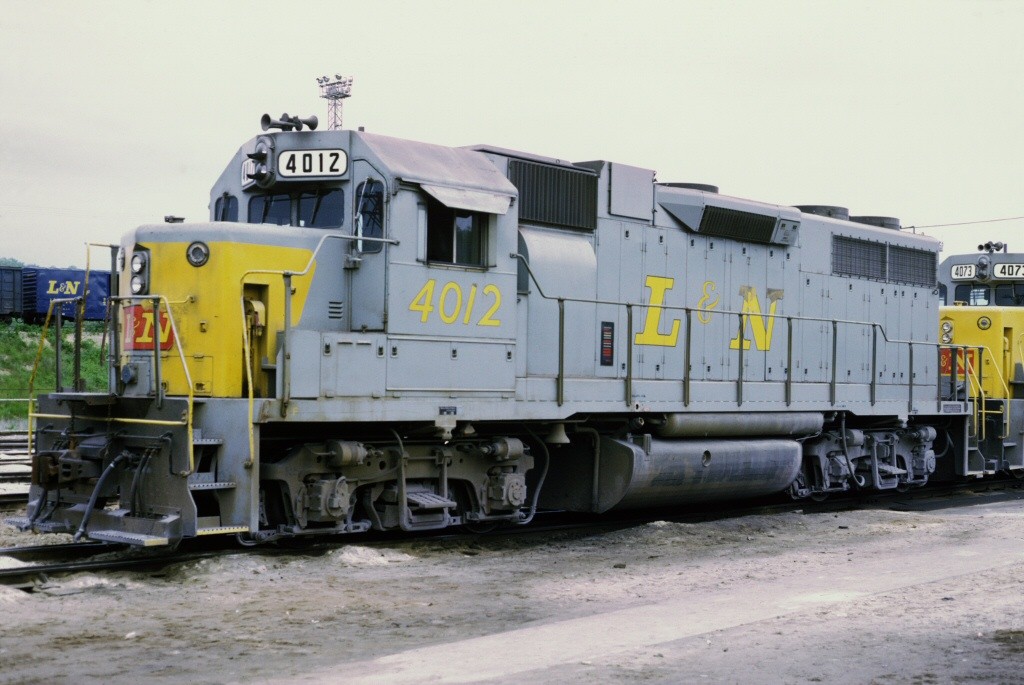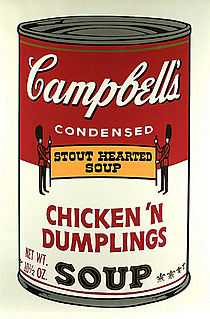Model Information:
Long desired by modelers looking to create urban and city type environments in which to operate their trains (be it for inner city trams or to replicate heavier weight train lines that allow freight and commuter lines to run through city centers), UNITRAM offers a versatile street track system that integrates with the included road places to create the illusion of a proper city environment.
Using both standard Unijoiners and variable track spacing on both straights (25mm) and in curves (33mm - standard double track width), it is possible to connect UNITRAM street tracks to both Kato UNITRACK single or Concrete-tie double tracks, allowing easy integration into existing layouts.
The track itself combines with street plates that use DIO-TOWN type connectors (Seen left, click for a larger image), allowing them to connect to other available street plates in the Kato UNITRACK product line. Use of these plates is optional for those modelers who wish to use their own scenery and cityscapes with Kato UNITRAM track.
The Basic starting Oval set can be used both independently as a compact city within your layout (the central area is designed to fit a number of Kato Dio-town buildings, or can be linked to a double track or multiple single track UNITRACK layouts thanks to the connection methods mentioned above. Additionally, other sets of UNITRAM pieces can be used to create larger and more elaborate street track setups.
UNITRAM is available both individually as well in a variety of packaged sets with Left-handed (Japanese style) street printing. Some Japanese-styled items may need to be special ordered through your local hobby shop. All of the information that you need can be found below, and you can contact your local hobby store to confirm availability.
The track itself combines with street plates that use DIO-TOWN type connectors (Seen left, click for a larger image), allowing them to connect to other available street plates in the Kato UNITRACK product line. Use of these plates is optional for those modelers who wish to use their own scenery and cityscapes with Kato UNITRAM track.
The Basic starting Oval set can be used both independently as a compact city within your layout (the central area is designed to fit a number of Kato Dio-town buildings, or can be linked to a double track or multiple single track UNITRACK layouts thanks to the connection methods mentioned above. Additionally, other sets of UNITRAM pieces can be used to create larger and more elaborate street track setups.
UNITRAM is available both individually as well in a variety of packaged sets with Left-handed (Japanese style) street printing. Some Japanese-styled items may need to be special ordered through your local hobby shop. All of the information that you need can be found below, and you can contact your local hobby store to confirm availability.
Road Name History:  Can't have model trains without track can we? The track on a railway or railroad, also known as the permanent way, is the structure consisting of the rails, fasteners, railroad ties (sleepers, British English) and ballast (or slab track), plus the underlying subgrade. It enables trains to move by providing a dependable surface for their wheels to roll upon. For clarity it is often referred to as railway track (British English and UIC terminology) or railroad track (predominantly in the United States). Tracks where electric trains or electric trams run are equipped with an electrification system such as an overhead electrical power line or an additional electrified rail.
Text and Images From Wikipedia
Can't have model trains without track can we? The track on a railway or railroad, also known as the permanent way, is the structure consisting of the rails, fasteners, railroad ties (sleepers, British English) and ballast (or slab track), plus the underlying subgrade. It enables trains to move by providing a dependable surface for their wheels to roll upon. For clarity it is often referred to as railway track (British English and UIC terminology) or railroad track (predominantly in the United States). Tracks where electric trains or electric trams run are equipped with an electrification system such as an overhead electrical power line or an additional electrified rail.
Text and Images From Wikipedia
Rail codes:
The code refers to the actual height of the rail. The followings heights are used for N-scale:
- Code 80 = 0.080" tall or about 13" N scale height - the mostly used for sectional tracks.
- Code 70 = 0.070" tall or about 11" N scale height
- Code 55 = 0.055" tall or about 9" N scale height - the mostly used by modelers wishing a realistic effect for their layout. Can be used with all modern rolling stock (low flange wheels).
- Code 40 = 0.040" tall or about 6" N scale height
Turnout codes:
The turnout number describes the length needed for the diverging track to be 1 foot apart from the straight one . So the lower the number, the sharper the curve, and the higher the number, the more gradual curve on the diverging track.
- In a #4 turnout, the rails are 1 foot apart at a distance 4 feet beyond the frog
- In a #6 turnout, the rails are 1 foot apart at a distance 6 feet beyond the frog
- In a #8 turnout, the rails are 1 foot apart at a distance 8 feet beyond the frog
Note that European brands such as Minitrix or Fleischmann use a different notation for turnouts and refer to the radius of the curvature of the diverging track.

Rail codes:
The code refers to the actual height of the rail. The followings heights are used for N-scale:
- Code 80 = 0.080" tall or about 13" N scale height - the mostly used for sectional tracks.
- Code 70 = 0.070" tall or about 11" N scale height
- Code 55 = 0.055" tall or about 9" N scale height - the mostly used by modelers wishing a realistic effect for their layout. Can be used with all modern rolling stock (low flange wheels).
- Code 40 = 0.040" tall or about 6" N scale height
Turnout codes:
The turnout number describes the length needed for the diverging track to be 1 foot apart from the straight one . So the lower the number, the sharper the curve, and the higher the number, the more gradual curve on the diverging track.
- In a #4 turnout, the rails are 1 foot apart at a distance 4 feet beyond the frog
- In a #6 turnout, the rails are 1 foot apart at a distance 6 feet beyond the frog
- In a #8 turnout, the rails are 1 foot apart at a distance 8 feet beyond the frog
Note that European brands such as Minitrix or Fleischmann use a different notation for turnouts and refer to the radius of the curvature of the diverging track.
Brand/Importer Information: Kato Precision Railroad Models (関水金属株式会社 Sekisui Kinzoku Kabushikigaisha) is a Japanese manufacturer of model railroad equipment in N and HO scales. The Tokyo-based company manufactures models based on Japanese prototypes (such as the Shinkansen bullet train) for the Japanese market, North American prototypes for the North American market and European high-speed trains for European market.
The Kato (pronounced kah-toe) model railroad companies were founded by Yuji Kato, father of current president Hiroshi Kato, of the parent company Sekisui Kinzoku Co., Ltd.
The design and distribution of models for the North American market are handled by their U.S. subsidiary, Kato USA, located in Schaumburg, Illinois.
The design of special models for the European market is handled for some of them by their partner, Lemke, whereas the general distribution of Kato products in Europe is handled by NOCH; both companies are located in Germany.
As a result, some Kato European models are sold as Kato Lemke and others as Kato (alone).
The Kato (pronounced kah-toe) model railroad companies were founded by Yuji Kato, father of current president Hiroshi Kato, of the parent company Sekisui Kinzoku Co., Ltd.
The design and distribution of models for the North American market are handled by their U.S. subsidiary, Kato USA, located in Schaumburg, Illinois.
The design of special models for the European market is handled for some of them by their partner, Lemke, whereas the general distribution of Kato products in Europe is handled by NOCH; both companies are located in Germany.
As a result, some Kato European models are sold as Kato Lemke and others as Kato (alone).
Item created by: gdm on 2023-04-06 10:14:49
If you see errors or missing data in this entry, please feel free to log in and edit it. Anyone with a Gmail account can log in instantly.
If you see errors or missing data in this entry, please feel free to log in and edit it. Anyone with a Gmail account can log in instantly.







